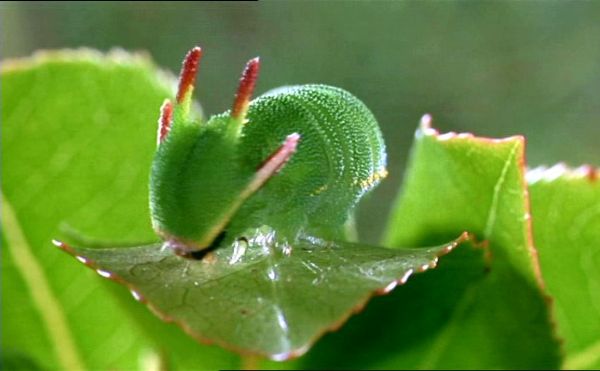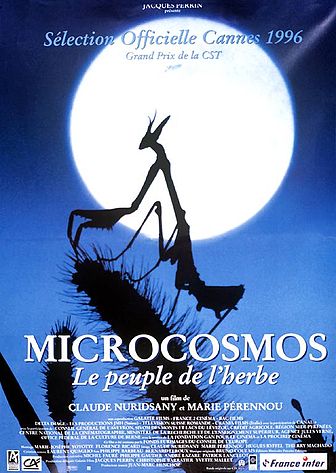Note: An earlier version of this essay appeared as a part of LoveFest I in The Dissolve comment section, organized by The Narrator Returns.
Selling a movie to the general public can be a tricky proposition. Some movies will almost sell themselves (Chris Pratt…a Raccoon that wears people clothes…“Hooked On a Feeling”……Whaddaya need, a road map?!?), while others need a more deft hand to communicate their idiosyncrasies and unique pleasures to an unknowing audience; but how best to make that connection with the public? For example, if you had Microcosmos, a lyrically poetic documentary about the small moments that make up the day-to-day lives of insects living in a meadow in France, a movie which largely uses only images, music and natural sound to tell it’s episodic stories, which only uses voice-over narration sparingly as a framing device and which has some of the most striking and mind-boggling examples of nature cinematography ever put to film, how would you present that to the public? Well, if you were Miramax in the mid-to-late 90’s and you actually had to solve that particular riddle, your answer would be one of the most Poochie-fied movie posters and subsequent DVD covers of all-time. You’ve heard the expression “let’s get busy”? Well, this is a praying mantis who gets biz-zay! Consistently and thoroughly.
Whether it’s the small-ish nature of the film or a botched poster/DVD cover job, for some unfortunate reason Microcosmos seems to be fairly unheeded. Even next to other like-minded films, it can still seem second-tier. It doesn’t seem to have the cult-movie cache of a Baraka or Samsara (both of which I’ve been able to see in 70MM, traveling roadshow style) and the only time I tend to see reference to Microcosmos pop-up in articles is when it’s mentioned as the previous film of the director of Winged Migration and Oceans (which is not entirely accurate! Microcosmos was directed by Claude Nuridsany and Marie Pérennou, biologists, photographers and filmmakers who’ve worked together since the ‘60s. French actor Jacques Perrin produced Microcosmos, provided the original French narration and went onto direct those other two films himself). Winged Migration is a great film in its own right, but while it picked up a Best Documentary Oscar nomination and got the 10 year anniversary DVD re-release, Microcosmos got left behind. Even in the sub-genre of impressionistic nature documentaries, Microcosmos seems overlooked.
Which is really too bad because the movie itself looks amazing. I’m a fan of cinematography for cinematography’s sake (I like me some purty pictures…) and Microcosmos has some truly stunning examples. The movie was filmed over the course of several years in the Aveyron region of France and the level of intimacy and detail that is captured on film is pretty remarkable. Directors Nuridsany & Pérennou and Cinematographer Thierry Machado capture moments where they either would have to have been incredibly meticulous, incredibly patient or incredibly lucky and either way their footage often feels like little triumphs over the odds. There are plenty of shots to puzzle over how exactly did they capture that?!? The filmmakers used specially built cameras to capture their up-close, “macroscopic” images but even when you assume that they are using zooms or magnifying lenses, there are still times where you have to wonder to yourself, “Wait, if they are getting this image, then where is the camera?” The effect can be both exhilarating and disorienting and it forces you to look at seemingly common things in a completely different way. Shots like an ant carrying a sunflower seed or taking a drink from a bead of water on a leaf are presented in such foreign proportions that the action becomes both more clear and more surreal at the same time. The technique is impressive and the results speak for themselves. The imagery is bright, colorful and bold; this is a film to watch on as big a screen as possible, in the highest definition you can muster.
It’s also to the film’s credit how much Nuridsany & Pérennou let their imagery play out without accompanying narration; we see clear examples of a bee and a flower collaborating in pollination, a butterfly emerging from its cocoon for the first time, a spider capturing grasshoppers in its web; yet, all these scenes play out without a voice-over spelling out or underlining exactly what it is we’re seeing. The film instead deploys an effectively used musical score (sometimes discordant, sometimes bombastic, sometimes wistful and sweeping), which helps give some of the imagery an emotional underpinning. But it’s ultimately left to the viewer to provide meaning; the film has a very quiet, contemplative quality to it. The narration that does exist is allusive and poetic, mostly used over the opening scene and a few other spots. Kristen Scott Thomas provides the narration for the English language version and after setting the scene she tells the viewer that “to observe this world we must fall silent now…and listen to its murmurs.” The film then switches to its sparse score and bits of natural sound to guide us through a closer look at this world.
What you see when you look closer is surprisingly relatable, too. The way that the Images and Sound interplay throughout the movie goes a long way towards creating small, episodic pieces of narrative. It doesn’t go to classic Disney: True-Life Adventure levels of personification, but there are some recognizable experiences and emotions in many of the film’s sequences and they help to create some memorable vignettes. The sequence when the rains come to the meadow plays out like a disaster film, threatening the security of the creatures caught out in the storm. A show-down between two horned-beetles plays like an epic battle of the highest stakes between two gladiators. The scene with the snails making out, set to a dramatic opera piece, feels weirdly intimate, like you stumbled onto something very private. We watch a dung beetle experience set-backs, frustration, confusion, determination and problem solving trying to transport his spoils to wherever he’s headed. We see rain-drops create cascading ripples in a pond and a ladybug holding on for dear life as the rain shakes the plant she’s grasping onto. The movie makes it clear what the stakes are for all of these creature’s lives by showing not telling.
Part of the film’s power comes from how it makes use of a confined setting (as the narration describes it, “A meadow in early morning…somewhere on Earth”) that simultaneously feels incredibly expansive. The film starts wide during the opening narration, literally up among the clouds, and it gradually pushes down closer and closer and closer, until it’s exploring tiny nooks and crannies on the ground inhabited by all sorts of different insects. The film glides from creature to creature, moving from vignette to vignette at a dreamlike pace. The variation of activity that the film finds and records is striking; in all these different creatures, going about their day-to-day existence, we see a wide range of motivations, aspirations, necessities and approaches to life on display.
There’s a metaphor at work here for the way certain things in life can often be overlooked or disregarded but, if one takes the time to look at them from the right angle, they can be revealed to have an immense amount of complexity and importance. The space that the film gives over to the viewer through it’s pensive, narration-free mix of image, sound and music really allows for ideas like this to creep in and take root. But the film really does leave it up to the viewer to ascribe any deeper meaning to the proceedings. There is a meditative quality to the way the film simply floats by but, while I feel like those themes are ever-present, the film doesn’t hit it too hard or too heavy-handedly. It’s just as easy to let these creatures simply be, to allow the movie’s incredible visuals to wash over you and just enjoy watching the insects going about their business.
Personally, I feel like the original French poster above is more closely aligned with the lyrical tone and allusive nature of the film, but, I do have to admit that the American poster back at the top of the page DOES capture something about the experience of watching the movie. I think that “IT’S JURASSIC PARK IN YOUR OWN BACK YARD” is not quite right (or, if I’m being less charitable, downright wrong), but, for all its poetic tones and quiet contemplation, in a lot of ways watching Microcosmos is really a lot of fun! It’s got laughs, it’s got surprising moments, it’s got cool stuff to look at and it’s got lots of bits to puzzle over and marvel at.
I first encountered Microcosmos a year or so after its release in a high school biology/zoology class which, in retrospect, doubled as a pretty decent film history class (it was also the first place I saw films by Jacques Cousteau or Jean Painlevé, as well…I guess our teacher had a thing for French nature documentaries!). On free days when the class was allowed to choose the video we would watch for ourselves, we always chose Microcosmos; I probably watched it in bits and pieces about three times over the course of that year. As a teaching tool, I could see how it can be really valuable for giving a glimpse into the world of insects and as a jumping off point for lessons on the environments and behaviors seen in the movie. But the film really does have more to offer than a scientific look into the world of insects. In the end, I have to agree with Roger Ebert, who wrote in his 4-star review that, “The movie is a work of art and whimsy as much as one of science…There is no other film like it.”
I just wish it had the audience to match its accomplishments.
Stray Observations:
–Microcosmos is currently streaming on Netflix.
-You’ll notice from those posters that Microcosmos was an Official Selection at Cannes 1996. It played out of competition (along with Flirting With Disaster, Girl 6 and Trainspotting) but it did win the Technical Grand Prize that year. Films in competition included Fargo, Breaking The Waves, Cronenberg’s Crash, with the Palme d’Or going to Secrets & Lies.
-The most notable thing about the movie is it’s cinematography, which really is pretty amazing. Here is an excellent article that breaks down the way the film uses its visuals and the slippery way it approaches “Documentary”, in much more detail than I could provide.
-SPOILER (maybe): It’s hard to get a lot of background information about the creation of the film; my DVD is very bare-bones and most articles about it on-line are in French. But using Googe Translate, I found this article which provides some interesting insight into how they achieved a lot of the shots in the film, with storyboards and some cool photos of them working on the film. The movie has no plot or story, really, so seeing how they actually captured some of these images is the only thing that one might consider a SPOILER.

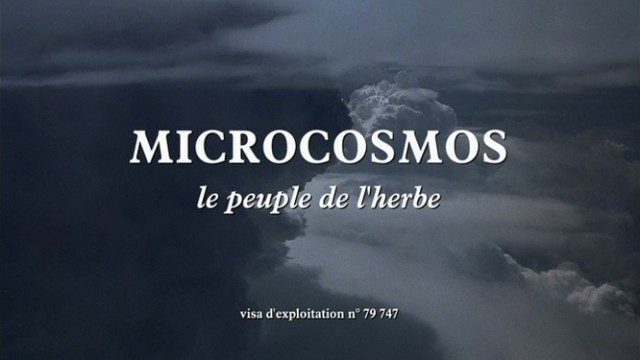
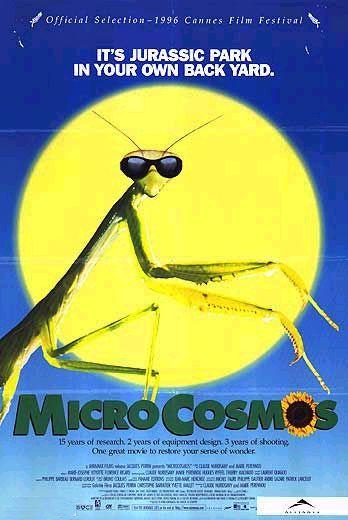
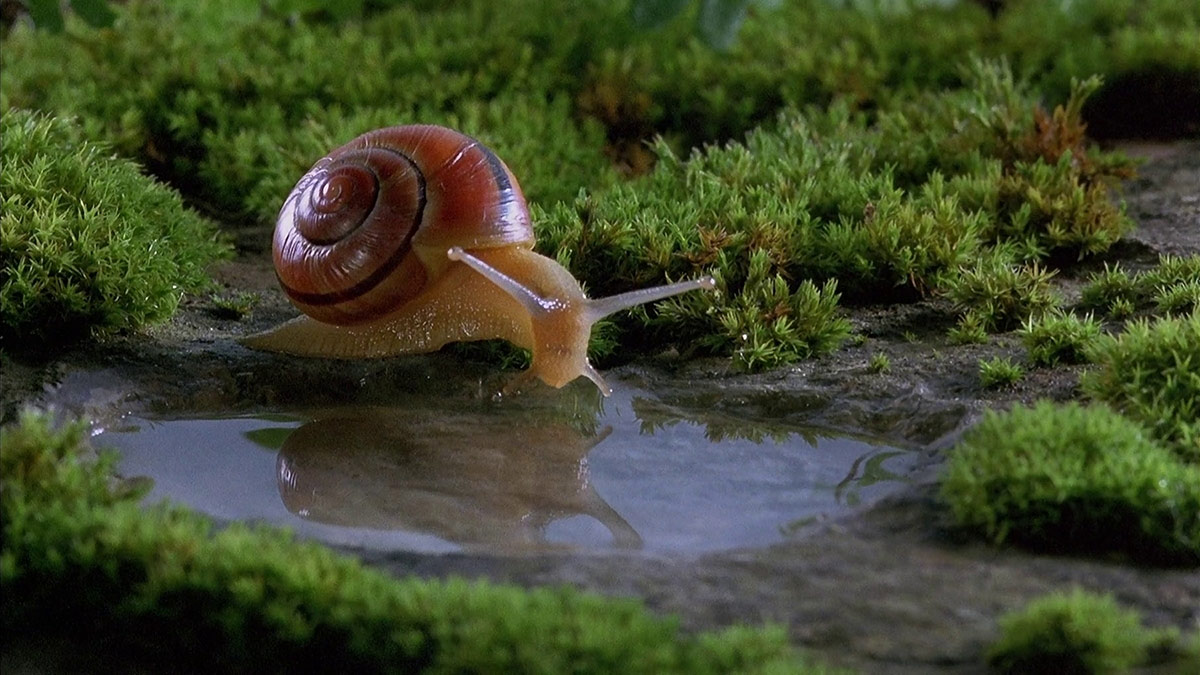
![microcosmos_02[1]](https://www.the-solute.com/wp-content/uploads/2015/10/microcosmos_021.jpg)
